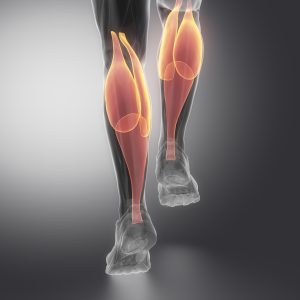Your calf muscles play a crucial role every time you walk, run and jump. Without healthy calf muscle function, you remain more vulnerable to lower limb fatigue and overuse injuries. During COVID-19, My FootDr has remained committed to helping our patients achieve their goals whether it be optimal health outcomes or improved performance. When it comes to calf injuries, or any injuries where the calf muscles have contributed to the problem, one of the ways that we have been helping is via telehealth appointments. Today, we’re giving you an insight into the efficacy of telehealth appointments to aid in the management of lower limb injuries – and how you’re able to access these services with our team.
The Power Behind Your Calves – Explained
Your calves are made of two primary muscles: the gastrocnemius and the soleus (with a smaller and much less likely to be injured plantaris muscle in there too). These are the outermost muscles at the back of the lower legs.

Your calves are responsible for pushing the front of your foot down and hence lifting your heel up – which is essential when you push off the ground to take a step. Think of the large amount of force exerted when you push off from your toes to move your whole body forwards during running or jumping – your calves play a major role in that. These muscles are incredibly strong and attach to your heel bone as the Achilles tendon. The Achilles tendon is the strongest tendon in your body and is able to take on a load exceeding 900 kilograms during running [2].
And If Your Calves Aren’t Working Effectively?
When there is a problem with the healthy function of the calf muscles, the risk of lower limb injury increases [1]. This includes injury to the calf muscles themselves, such as a muscle tear, strain or rupture, as well as other painful injuries where tight or weak calf muscles play a role in development. Examples include stress fractures, knee pain, or problems associated with increased pressure on the forefoot [4].
The Role Of Telehealth In Injury Rehabilitation & Calf Assessment
Even before COVID-19, telehealth played an important role in connecting those living in rural and remote locations with professional healthcare services. When it comes to successful rehabilitation, a key component is the accurate and precise completion of prescribed exercises that are designed to help build strength and lengthen the muscles to promote healthy function. Performing strengthening and stretching techniques incorrectly can be a simple mistake to make, but may significantly slow down your progress and results.
In 2018, an Australian-based study that examined the assessment of calf exercises in patients with Achilles problems via telehealth appointments had moderate-to-excellent reliability and validity, compared with completing this assessment in person [3]. These findings support the use of telehealth in musculoskeletal rehabilitation and means that, regardless of social distancing restrictions, illness or physical location barriers, we are able to continue to provide optimum care for you, helping to improve your treatment and rehabilitation outcomes.
How To Access Our Telehealth Services Today
Currently, we are still open and providing care for our patients. For those who are self-isolating, in quarantine or would prefer not to come into the clinic for an appointment, telehealth may be right for you. You can learn more and book your telehealth appointment at your nearest clinic by clicking here.
While there are both clinical and practical considerations to telehealth, our team can help inform you about whether a telehealth consultation is suitable for the problem you are experiencing. You can speak to our team directly by calling us on 1800 FOOT DR.
References
[1] – https://www.ncbi.nlm.nih.gov/pmc/articles/PMC2697334/
[2] – https://www.sciencedaily.com/releases/2017/11/171120085811.htm
[3] – https://australian.physio/inmotion/reliability-and-validity-telerehabilitation
[4] – https://www.medicalnewstoday.com/articles/tight-calves


